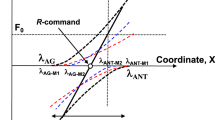Abstract
The present paper focused on the role of mechanical factors arising from the multijoint structure of the musculoskeletal system and their use in the control of different patterns of cyclical elbow-wrist movements. Across five levels of cycling frequency (from 0.45 Hz up to 3.05 Hz), three movement patterns were analyzed: (1) unidirectional, including rotations at the elbow and wrist in the same direction; (2) bidirectional, with rotation at the joints in opposite directions, and (3) free-wrist pattern, which is characterized by alternating flexions and extensions at the elbow with the wrist relaxed. Angular position of both joints and electromyographic activity of biceps, triceps, the wrist flexor, and the wrist extensor were recorded. It was demonstrated that control at the elbow was principally different from control at the wrist. Elbow control in all three patterns was similar to that typically observed during single-joint movements: elbow accelerations-decelerations resulted from alternating activity of the elbow flexor and extensor and were largely independent of wrist motion at all frequency plateaus. The elbow muscles were responsible not only for the elbow movement, but also for the generation of interactive torques that played an important role in wrist control. There were two types of interactive torques exerted at the wrist: inertial torque arising from elbow motion and restraining torque arising from physical limits imposed on wrist rotation. These interactive torques were the primary source of wrist motion, whereas the main function of wrist-muscle activity was to intervene with the interactive effects and to adjust the wrist movement to comply with the required coordination pattern. The unidirectional pattern was more in agreement with interactive effects than the bidirectional pattern, thus causing their differential difficulty at moderate cycle frequencies. When cycling frequency was further increased, both the unidirectional and bidirectional movements lost their individual features and acquired features of the free-wrist pattern. The deterioration of the controlled patterns at high cycling frequencies suggests a crucial role for proprioceptive information in wrist control. These results are suppportive of a hierachical organization of control with respect to elbow-wrist coordination, during which the functions of control at the elbow and wrist are principally different: the elbow muscles generate movement of the whole linkage and the wrist muscles produce corrections of the movement necessary to fulfill the task.
Similar content being viewed by others
Author information
Authors and Affiliations
Additional information
Received: 5 August 1997 / Accepted: 29 January 1998
Rights and permissions
About this article
Cite this article
Dounskaia, N., Swinnen, S., Walter, C. et al. Hierarchical control of different elbow-wrist coordination patterns. Exp Brain Res 121, 239–254 (1998). https://doi.org/10.1007/s002210050457
Issue Date:
DOI: https://doi.org/10.1007/s002210050457



